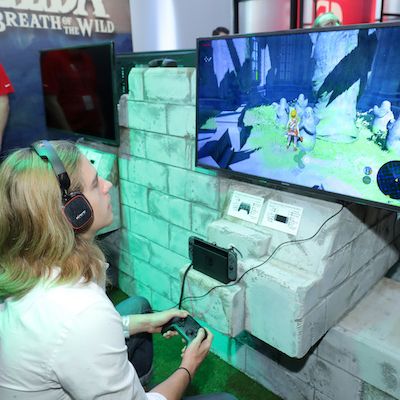
I spent most of today at a hotel in the Flatiron, getting a lot of hands-on time with Nintendo’s newest console, the Nintendo Switch, coming out March 3 for $299. After making my way through most of the demos on the floor, I’m convinced Nintendo’s hybrid mobile–home console is going to be a hit — but there are still a few things that worry me. What I loved and what I’m concerned about below.
The pull-away mobile console concept just works
Similar to 2-in-1 laptops, which can convert from traditional laptops into tablets with a quick flip, the Switch’s central conceit is pulled off brilliantly. In multiple different games, pulling the tablet up and pushing the controllers on the side took a 20 seconds before I had what is probably the most powerful mobile console around right now. Along with a lot of other people, I was a bit surpsied Nintendo went with $299 for its launch price, considering I can buy a base PS4 or Xbox One for less right now. After using it for a while, I think the $299 number is going to work. In mobile the resolution is sharp, the colors are bright, and the essential feel of each game felt unchanged — except I could now carry it anywhere I wanted.
You can do a lot with these controllers
The controllers, or “Joy-Cons” as Nintendo is calling them (which, sure), have a lot of capability built into them. They work fine when paired up and just used as a standard sit-back couch controller, and they work equally well when stuck on the side of Switch when mobile. But two of the best games on the floor showed off what else they could do. Arms, a futuristic robot boxing game, used the Joy-Cons remotely to essentially create a version of Wii Boxing that’s incredibly fun. Their ability to detect finer movements, like twists of the hand or the difference between a slow and fast punch, made for a game that should have felt like a frenzied slugfest turn into something much more tactical and deeper. The other game, Snipperclips, uses the ability of the Switch to split the two Joy-Cons between two players to create a fun, weird, and cooperative puzzle game that had me laughing like a loon with a complete stranger. (That said, a lot of the games on the floor were using the Pro controller, which won’t be sold with the base Switch unit — a sign that anyone who plans to do a lot of couch gaming may need to shell out even more for the system.)
The Legend of Zelda: Breath of the Wild
Toward the end of the day, as crowds started to thin, plenty of demo stations started getting empty. But the dozen-odd stations showing a 20-minute demo of The Legend of Zelda: Breath of the Wild never did. There’s a reason for this, beyond just the built-in audience for any Legend of Zelda game — it looks and feels incredible. Nintendo has taken the basic concept they’ve been using since Ocarina of Time and matured it in a number of ways. You’ll find yourself switching between multiple weapons and fighting styles, crafting items in order to sneak through enemy camps, bum-rushing enemies with just a stick hoping that you can somehow knock the weapon out of their hands. And that’s just in the first 20 minutes. Nintendo needed a game to get people in the door for the Nintendo Switch, and this has the potential to be maybe the best open-world RPG yet, on any system. (And it still played great on mobile, for what it’s worth.)
There’s a lot of third-party support
While first-party titles may have dominated the floor, plenty of smaller studios made showings. Games like Fast RMX, Has-Been Heroes, and the above mentioned Snipperclips all showed third-party developers are, at least for now, turning out for Nintendo’s new system. Lack of third-party developer enthusiasm is one of the several things that doomed the Wii U, so it’s heartening to see that Nintendo seems serious about courting them back into the fold.
As for what worried me:
Just how mobile is the Switch really going to be?
The official word from Nintendo is that, depending on the game, you can expect two-and-a-half to six hours of battery life. Which is fine for a bus ride, but not so much for a cross-country trip or a long Amtrak ride. You can power up the Switch in mobile mode with a USB charger, and it’s understandable what’s essentially a thin gaming tablet isn’t going to give you 20 hours of battery life, but it is a bummer. Second, while the Switch fits comfortably in your hands, there’s no way it could ever fit comfortably in your pocket, unlike, say, the Nintendo 3DS. To really have this on the go, you’ll need to be carrying a bag of some sort. It’s also unclear just how sturdy the Joy-Cons are going to be bumping around with the rest of your stuff — analog sticks can be notoriously easy to break.
Is Nintendo going to figure out its supply chain?
I was able to sit down with David Young of Nintendo of America, who assured me that Nintendo is planning an initial run of 2 million consoles — a healthy number considering the Wii U has sold just an estimated 13.4 million units in its entire lifetime. Still, if the Switch is as popular as I think it’s going to be, consumer frustration with not being able to lay hands on one is going to be immense if not enough units continue to be brought to market after launch. Many will simply wait, but there will be some who’ll simply give up and go back to their PS4 or Xbox One.





























